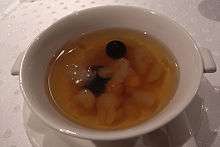Hasma
|
Dried Hasma sold in a box | |
| Alternative names | Harsmar, hashima, toad oil |
|---|---|
| Type | Pastry |
| Place of origin | China |
| Region or state | Heilongjiang, Jilin, and Liaoning |
| Main ingredients | Fatty tissue found near the fallopian tubes of true frogs |
|
| |
| Hasma | |||||||||||
| Chinese |
1. 雪蛤 2. 雪蛤膏 | ||||||||||
|---|---|---|---|---|---|---|---|---|---|---|---|
| |||||||||||
| Alternative Chinese name | |||||||||||
| Chinese | 哈士蟆 | ||||||||||
| |||||||||||
Hasma (Harsmar, Hashima) is a Chinese and widely Central Asian dessert ingredient made from the dried fatty tissue found near the fallopian tubes of true frogs, typically the Asiatic Grass Frog (Rana chensinensis). Because of its whitish appearance, Hasma is often mistakenly described as "snow frog fat".[1] The Western pharmaceutical term is Oviductus Ranae.
Production
Hasma is produced primarily in the Heilongjiang, Jilin, and Liaoning provinces in China. Previously available only to Emperors, soups made with hasma are available in North American cities with large Chinese populations and in China, Taiwan, Singapore and Hong Kong.
Physical characteristics
Hasma is sold dried as irregular flat pieces and flakes ranging from 1–2 cm in length and 1–5 mm in thickness. Individual pieces are yellowish-white in colour with a matte lustre, whose surface may be covered with off-white pellicles. When rehydrated, dried hasma can expand up to 10-15 times in size.
The dried hasma is rehydrated and double-boiled with rock sugar to create a glutinous texture and opaque color. Dried or rehydrated hasma has a slight fishy smell. In its unflavoured form it is sweet and slightly savory in taste with a texture that is glutinous, chewy, and light, very similar to that of tapioca in a dessert.
Preparation

Hasma serves the role of providing texture to tong sui, or sweet soups, as well as increasing the perceived luxuriousness of the soup. These soups are usually flavoured with rock sugar. For the uninitiated, this relatively accessible eating experience belies the exotic sounding nature of the dessert. Hasma is widely featured in dessert dishes in high class restaurants in Hong Kong.
Hasma is most commonly paired in sweet soups with:
- Jujubes (Chinese: 紅棗; pinyin: hóng zǎo; literally: "red date")
- Dried longan fruits (Chinese: 龍眼; pinyin: lóng yǎn; literally: "dragon eye")
- Lotus seeds (Chinese: 蓮子; pinyin: lían zĭ)
It is also a key ingredient in making "Three snow soup" (Chinese: 三雪湯; pinyin: sān xuě tāng), which consists of:
- Chinese pear (Chinese: 雪梨; pinyin: xuě lí; literally: "snow pear")
- Snow fungus (Chinese: 雪耳; pinyin: xuě ěr; literally: "snow ear")
Hasma can also be included in more exotic versions of shark fin soup.
Health claims
Hasma is taken for medicinal purposes in Traditional Chinese medicine. Hasma is prescribed to treat respiratory symptoms, though scarce research support this practice.[1] It is also a suggested remedy for stomach ulcers and used to improve the look of skin.
References
- 1 2 Deutsch, Jonathan; Murakhver, Natalya (2012). They Eat That?: A Cultural Encyclopedia of Weird and Exotic Food from Around the World. ABC-CLIO. p. 75. ISBN 978-0-313-38058-7.
